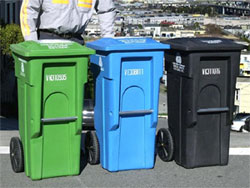Recycling isn’t big news anymore now that most cities do it, but recycling rates have leveled off for years, with most "successful" programs reaching the 30% range instead of continuing to grow.
San Francisco has reached an unheard of 80% landfill diversion rate, way higher than any other city in North America. It has therefore upped its goal of 75% diversion by 2020 to zero waste.
It does so through source reduction, reuse, and mandatory recycling and composting programs, that are backed by innovative policies, financial incentives, outreach and education.
What’s makes the program so successful?
First, they accept many more materials for recycling than most cities do (and have invested in the infrastructure to sort it), and second they require both households and businesses to recycle and compost.
San Francisco was the first city to require composting (where people put out compostable materials for pick-up), which has also contributed to meeting its successful target of cutting greenhouse gas emissions 12% below 1990 levels.
Here are the bins they use: blue for recycling (paper, plastics, glass and metals), green for food scraps and other organic matter, and black for garbage that can’t currently be recycled.

Last year, Governor Brown signed a law that extends the requirement for recycling and composting: commercial businesses must participate if they generate four or more cubic yards of garbage a week as well as multifamily dwellings with five or more units.
As in most states, although businesses create about two-thirds of the waste stream, few recycle, according to Californians Against Waste.
Also last year, San Francisco expanded its first-in-the-nation ban on non-compostable plastic bags to include almost all retailers in the city.
State of US Recycling
Recycling is a largely an unrecognized but major contributor to energy efficiency – it takes much less energy to produce new products from recycled ones, rather than mining virgin material from the ground.
Composting is critical for soil health and keeping those materials out of landfills solves the problem of methane leaching caused when they decompose in an oxygen deprived situation.
If all US cities recycled and composted like San Francisco that would create 2.3 million jobs.
Even though San Francisco has cut waste-to-landfills by half over the past 10 years, it still sends 444,000 tons to the landfill each year – enough to fill the TransAmerica building nine times. Half of that material could be recycled or composted – imagine the waste other cities produce.
That remaining waste is mostly coming from neighborhoods where English isn’t the first language, not from non-compliance, so staff are reaching out to help them understand the program.
In the report, "Closing the Loop," GreenBlue recommends expanding US recycling through:
- Clear, nationally-coordinated waste policies, including extended producer responsibility legislation
- Ongoing public education campaigns encouraging participation in recycling and composting
- "Hub and spoke" regional recycling in rural areas
As of 2010, the US recycled 34% of garbage, which amounts to 85 million tons out of a total 250 million tons, a big rise from 10% in 1980, before the advent of recycling programs. Less than 3% of food scraps are composted nationwide. The amount of garbage Americans produce is slightly inching down, from a high of 4.57 pounds per person a day in 1990 to 4.43 pounds today.
Learn more about the importance of the recycling industry.
Read about SF’s program:

SF should also export its recycling model to other countries. Norfolk in England needs to very much improve its recycling rates for example.